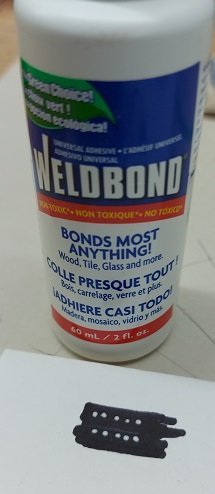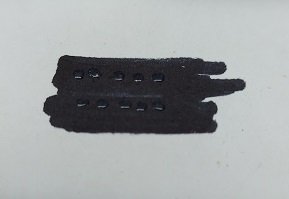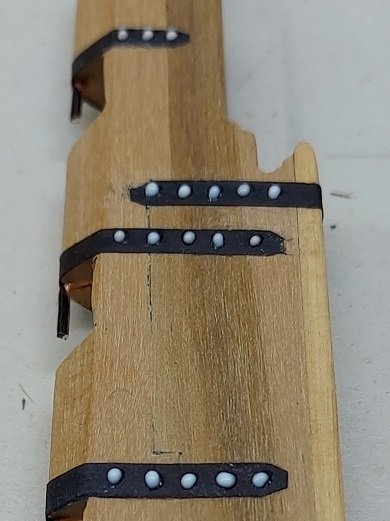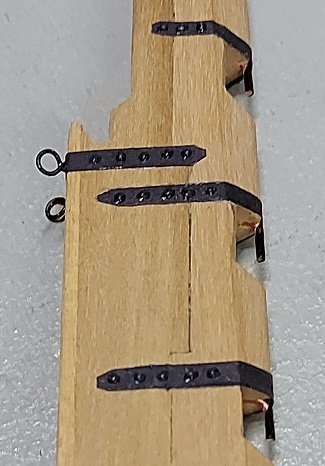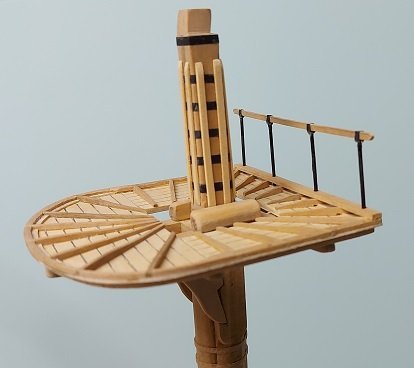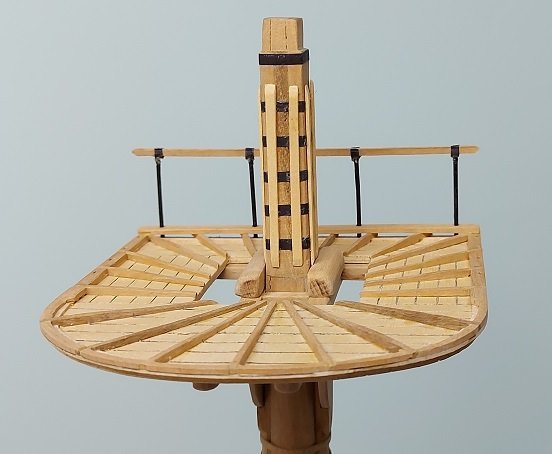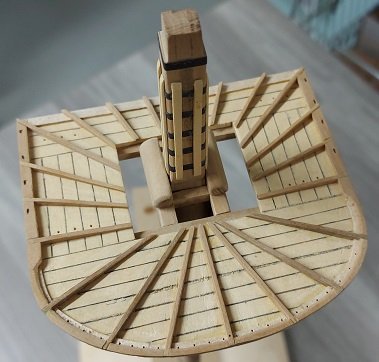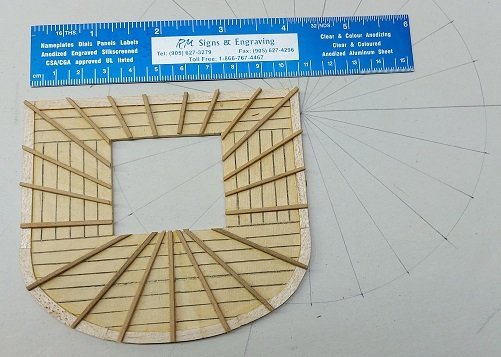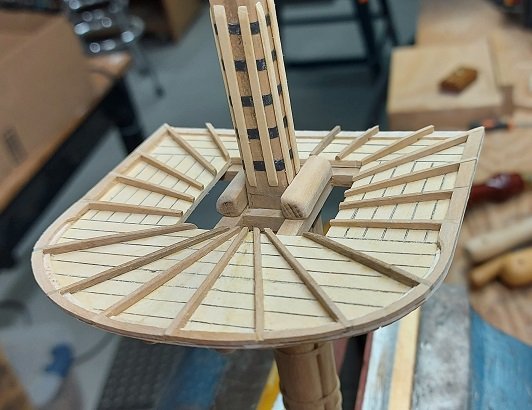-
Posts
2,860 -
Joined
-
Last visited
Content Type
Profiles
Forums
Gallery
Events
Everything posted by AON
-
So here is the test with weld bond glue to simulate bolt heads with a thank you to John Cairns of our local Niagara Region club for demonstrating this technique to create shapes on small parts (i.e. insignia like a royal cypher on a gun barrel) Test wet and dry... Here it is on the rudder ... up close and personal. It looks much better from 12 inches away! Rudder wet and dry and full view. The great thing is I can wipe it off when wet and do it again, or when dry (hours or weeks later) I can easily add to it.
-
and to continue... Main Caps Length = 4 x the diameter of the Top Mast plus 3" Breadth = 2 x the diameter of the Top Mast plus 2" Depth = 4/9 x the Breadth Fore Caps Length = 4 x the diameter of the Top Mast plus 2" Breadth = 2 x the diameter of the Top Mast plus 1" Depth = 4/9 x the Breadth Mizen Cap Length = 4 x the diameter of the Top Mast plus 1" Breadth = 2 x the diameter of the Top Mast Depth = 4/9 x the Breadth so I am ready to make my Main Cap.
-
I was called away... so to finish the last post: Trestle Tree Length = 1/4 the length of the Top Mast Depth = 1/2 the Top Mast diameter Thickness = 2/3 x the Depth Undersides snaped (tapered) at each end One end 1 and a 1/2 x the depth; other end 1 x the depth, within the ends Snapes are lined to 1/2 the depth of the trestle tree and rounded to a sweep at the ends The lower outer edge is chamfered the full length The lower inner edge is chamfered to the cross trees Chamfered on the undersides The longest snapes are the foremost ends of the main trestle trees and the aft ends of the foremast trestle trees (nothing mentioned about the mizzen mast!) Cross Trees Length = 1/3 the length of the Top Mast less 6" Breadth = thickness of the Trestle Trees Depth = 2/3 the Breadth Tapered (snaped) at each end on the underside to 1/4 the length of the cross tree, from the end to 1/2 the depth, and round the ends with a sweep
-
For those interested... My main mast platform and trees were made from measuring images found on steels plate 3. I searched high and low to find information on the size of the foremast and mizzen mast platform (tops). On Saturday, at the Chicago NR&MS club virtual meeting I was told to look in Steels Mast Making Vol 1. This was where I found the plates and I had looked before but could find nothing on the platform (tops). It ends up I simply could "see the forest for the trees"! There on page 25/26 was a description of the sizes of the timbers for the trees. The platform sits on the trees and so would be made to suit them. I was searching for the platform when I should have been looking for the trees!
-
Did a few different things yesterday. Got two more frames glued, I'll be sanding the chocks down to be flush with the timbers, drilling the bolt holes and adding the bolts today. Made my main mast top rail and stanchions. I've seen support stanchions square with fancy turned parts, or square with flutes, or square with chamfers, or round iron bars. All had iron grips at the top that the wooden rail slipped into. I decided to do the latter. I used bamboo and a draw plate to get them down to size. The rail grips were blackened bond paper glued to the three sides (not the top). The stanchions were also blackened with black permanent marker. Both the platform and rail were drilled. I sharpened the top end of each stanchion with my tiny mechanical pencil lead sharpener so they would poke into the glued drilled pocket on the underside of the rail, and put a dab of glue on the foot end of the stanchion. They were assembled and held for the longest time until the glue held up. The tops are not glued to the trees in the above picture. I won't be doing that for some time yet. I'll be marking the mast bolt locations, drilling, and adding the bolts to the mast assembly today (monofilament fishing line). I then pulled out my rudder that I'd made some time ago and added pintles and banding to it. Once again using blackened bond paper. I used 0.04" copper wire for the pintles. Drilled snug fit holes in the forward face of the rudder just above the pintle/gudgeon pockets (where the banding goes). Filed a point on one end of the wire (nail like) and inserted it (pointed end) into the rudder. Gave it a few gentle knocks with a tack hammer to set it, then bent it over with miniature pliers. These were blacked with permanent marker. The banding was added which covers the hole. Today I will do a test to add faux bolt heads with drops of Weld Bond glue applied with a pointed applicator to the blackened paper. As it dries clear I imagine the black colour will come through but a "bolt head bump" will be visible. I will post photos after the job is done.
-
From what I've learnt so far (liquid) resin which involves dipping into a liquid bath requires washing and rinsing. PVA filaments do not need to be washed or rinsed.
- 321 replies
-
- Finished
- Flower-class
-
(and 1 more)
Tagged with:
-
OMG That was hiding in your closet? I've got to go check mine! 😁 I haven't followed plastic models, but I think I'll join you. This looks interesting.
-
Over 20 hours! very nice. 8 hours of printing concerns me as I've had failures occur part way through. I hope you never experience those.
- 321 replies
-
- Finished
- Flower-class
-
(and 1 more)
Tagged with:
-
Very nice prints! BZ I see the section is a good thickness, I imagined thinner and thought you might have a problem. Should be easy to glue the pieces but I would test your plastic glue on some scrap if you've not used it on PLA before as it might melt the part. That was my experience. I ended up using a 2 part epoxy. I found the PLA a pain to finish (sand smooth). They say a wet sand paper should be used. Have you done this before? Can't wait to see this come together.
- 321 replies
-
- Finished
- Flower-class
-
(and 1 more)
Tagged with:
-
I am very interested in your Corvette build. May I ask.... Are you using PLA material in this printer. What size nozzle will you be using? How thick is the hull? I am a novice 3D printer. Using an JG Aurora A5 3D printer with a full set of nozzles. I tried printing 1:64 scale 18th century gun barrels with black PLA filament, and gun carriages with PLA/Wood filament. The barrels were impossible but the carriages were a success. I had a friend from our local club print my barrels in his liquid resin printer. I had success with a 1:12 scale gun barrel. Alan
- 321 replies
-
- Finished
- Flower-class
-
(and 1 more)
Tagged with:
-
Below is a photo of the holes and slots done. The fore part of the deck is not quite as pretty as I had hoped for as I moved two battens and alcohol swabbing and scraping to remove the glue residue didn't quite clean up as nicely as I had imagined it would. I'll get the aft railing done next and attempt a repair up forward.
-
Main mast platform shroud deadeye slots. As no sources seem to agree and having chewed this over for days, and looking at it logically, I've made a decision. Four. Exactly what Steels tables read. I looked at the distance the deadeyes were spaced between, then divided this by 3, 4 and 5 to get the possible interval distance for 4, 5 and 6 deadeyes. I then subtracted the size of the deadeye to get the physical gap dimension between deadeyes. Thought about how much space a sailor might need to climb up. Took my pencil template and penciled in the location of 4, 5 and 6 deadeyes. How did they relate to the location of my stiffening battens. Considered how a greater number of shrouds would reduce the footing clearance at the dead end of the shrouds. This last bit was brought to my attention by a member of our local club as I reviewed my thought process with him. Six was too much. Five was a possibility. Four ticked all the boxes. Now I need to figure out the number of holes for the crowsfeet. I've seen 20 and 18 for this platform... and just now 30! I've decided on 18 simply because when laid out the spacing works and the look of it is pleasing. I'll be drilling these holes and making my stanchions now.
About us
Modelshipworld - Advancing Ship Modeling through Research
SSL Secured
Your security is important for us so this Website is SSL-Secured
NRG Mailing Address
Nautical Research Guild
237 South Lincoln Street
Westmont IL, 60559-1917
Model Ship World ® and the MSW logo are Registered Trademarks, and belong to the Nautical Research Guild (United States Patent and Trademark Office: No. 6,929,264 & No. 6,929,274, registered Dec. 20, 2022)
Helpful Links
About the NRG
If you enjoy building ship models that are historically accurate as well as beautiful, then The Nautical Research Guild (NRG) is just right for you.
The Guild is a non-profit educational organization whose mission is to “Advance Ship Modeling Through Research”. We provide support to our members in their efforts to raise the quality of their model ships.
The Nautical Research Guild has published our world-renowned quarterly magazine, The Nautical Research Journal, since 1955. The pages of the Journal are full of articles by accomplished ship modelers who show you how they create those exquisite details on their models, and by maritime historians who show you the correct details to build. The Journal is available in both print and digital editions. Go to the NRG web site (www.thenrg.org) to download a complimentary digital copy of the Journal. The NRG also publishes plan sets, books and compilations of back issues of the Journal and the former Ships in Scale and Model Ship Builder magazines.





